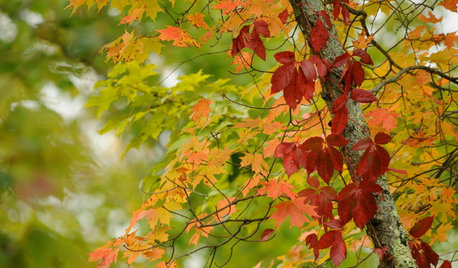Browning leaves on my Spathiphyllum
haggis_2006
12 years ago
Related Stories

GARDENING GUIDESWhat's Wrong With My Plant? Leaves Often Hold the Clues
Learn how to identify common plant ailments by reading their leaves
Full Story
REMODELING GUIDESInterior Brick: Paint it or Leave It?
Here's how to know if covering that brick is a sin or solution
Full Story
FALL GARDENING5 Ways to Put Fall Leaves to Work in Your Garden
Improve your soil and yard the organic way with a valuable garden booster that grows on trees
Full Story
BROWNColor Guide: How to Work With Brown
It's all over nature and the decorating world too. From light latte to dark walnut, there's a brown for everyone
Full Story
COLORFall on the Wall: Decorating With Rich Reds, Browns and Oranges
For your interiors, take a cue from nature’s colorful seasonal offerings
Full Story
DECORATING GUIDESInspired by Fall: Reds, Oranges and Browns at Home
Add just an accent or rake in the color with shades of autumn all over the house
Full Story
GARDENING GUIDESGot Frost-Damaged Plants? How It Happens, and When and How to Prune
Crispy brown leaves are a sure sign that Jack Frost has been to your neighborhood
Full Story
CURB APPEALWhen to Paint Your House Brown
Nature loves brown, from rich soil to sunlit sand, and so do home exteriors with a traditional or Craftsman bent
Full Story
COLORWhy You Should Give Brown a Chance
If 'blech' is your first response to brown, you're missing out on the opportunity for a warm-looking room that appeals to both sexes
Full Story
GREENColor Combinations: Brown and Green
Take Your Cue from Nature for the Most Classic Color Combination of All
Full StorySponsored
Columbus Area's Luxury Design Build Firm | 17x Best of Houzz Winner!
More Discussions








stonesriver
tapla (mid-Michigan, USDA z5b-6a)
Related Professionals
Canton Landscape Architects & Landscape Designers · Fitchburg Landscape Architects & Landscape Designers · Forest Acres Landscape Architects & Landscape Designers · Port Royal Landscape Architects & Landscape Designers · Roosevelt Landscape Architects & Landscape Designers · Canton Landscape Contractors · Emmaus Landscape Contractors · Fort Wayne Landscape Contractors · Morrisville Landscape Contractors · Oxnard Landscape Contractors · Thonotosassa Landscape Contractors · Markham Landscape Contractors · New Carrollton Landscape Contractors · Silver Firs Landscape Contractors · Linton Hall Interior Designers & Decoratorsstonesriver
tapla (mid-Michigan, USDA z5b-6a)
haggis_2006Original Author
tapla (mid-Michigan, USDA z5b-6a)
zzackey
jean001a
birdsnblooms
tapla (mid-Michigan, USDA z5b-6a)
stonesriver
birdsnblooms
greenman28 NorCal 7b/8a
tapla (mid-Michigan, USDA z5b-6a)
birdsnblooms
stonesriver
greenman28 NorCal 7b/8a
tapla (mid-Michigan, USDA z5b-6a)
kaktuskris
jodik_gw
tapla (mid-Michigan, USDA z5b-6a)
birdsnblooms
stonesriver
dellis326 (Danny)
birdsnblooms
Rolan Yang
tapla (mid-Michigan, USDA z5b-6a)